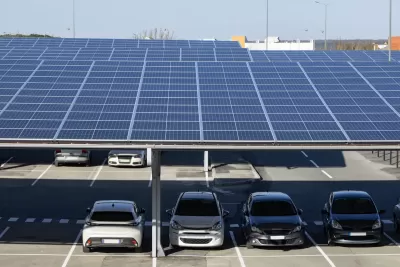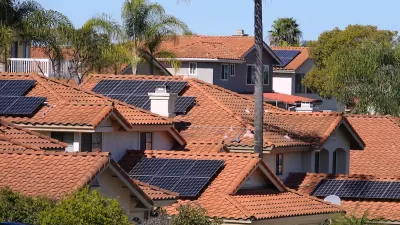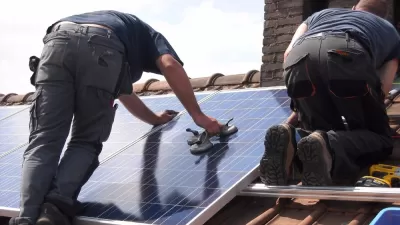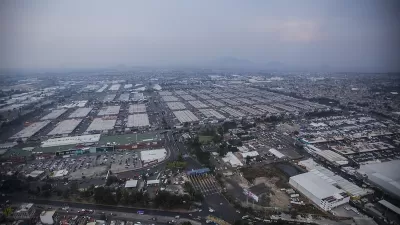Massive swaths of flat rooftops, garages, and surface parking lots go underutilized. They could be producing renewable energy.

In an article for Clean Technica, Steve Hanley describes the promise of rooftop solar panels on large commercial properties and parking lots using three examples. “The beauty part is that using those roofs to generate solar power turns the owners of those properties into prosumers — people who both produce and consume their own locally generated electricity,” Hanley explains. Commercial energy users can more accurately predict what electricity will cost them over the long term.
In Maryland, a $4.8 million state program offers funding for solar power installations on parking garages and lots, which double as weather shelters. The program encourages applications with dual uses, such as projects that support community microgrids and local businesses. In Wisconsin, a Ford dealer in Fond du Lac installed solar arrays on two facilities that can produce half of the buildings’ energy needs.
On the product side, a UK company has developed an ultra-lightweight solar power system that can be installed on rooftops not suited for heavier, traditional panels. According to Hanley, just 5 percent of warehouse roof space in the UK is covered with solar panels. “A recent analysis estimates the total area of unused rooftops in the UK is 165 million square meters (1.8 billion sq. ft), with a potential solar capacity of nearly 25 GW — roughly equivalent to 25 average size nuclear power plants.”
FULL STORY: Rooftop Solar On Commercial Properties & Parking Lots Is The Next New Thing

Trump Administration Could Effectively End Housing Voucher Program
Federal officials are eyeing major cuts to the Section 8 program that helps millions of low-income households pay rent.

Planetizen Federal Action Tracker
A weekly monitor of how Trump’s orders and actions are impacting planners and planning in America.

Ken Jennings Launches Transit Web Series
The Jeopardy champ wants you to ride public transit.

Washington Legislature Passes Rent Increase Cap
A bill that caps rent increases at 7 percent plus inflation is headed to the governor’s desk.

From Planning to Action: How LA County Is Rethinking Climate Resilience
Chief Sustainability Officer Rita Kampalath outlines the County’s shift from planning to implementation in its climate resilience efforts, emphasizing cross-departmental coordination, updated recovery strategies, and the need for flexible funding.

New Mexico Aging Department Commits to Helping Seniors Age ‘In Place’ and ‘Autonomously’ in New Draft Plan
As New Mexico’s population of seniors continues to grow, the state’s aging department is proposing expanded initiatives to help seniors maintain their autonomy while also supporting family caregivers.
Urban Design for Planners 1: Software Tools
This six-course series explores essential urban design concepts using open source software and equips planners with the tools they need to participate fully in the urban design process.
Planning for Universal Design
Learn the tools for implementing Universal Design in planning regulations.
Heyer Gruel & Associates PA
Ada County Highway District
Institute for Housing and Urban Development Studies (IHS)
City of Grandview
Harvard GSD Executive Education
Toledo-Lucas County Plan Commissions
Salt Lake City
NYU Wagner Graduate School of Public Service





























